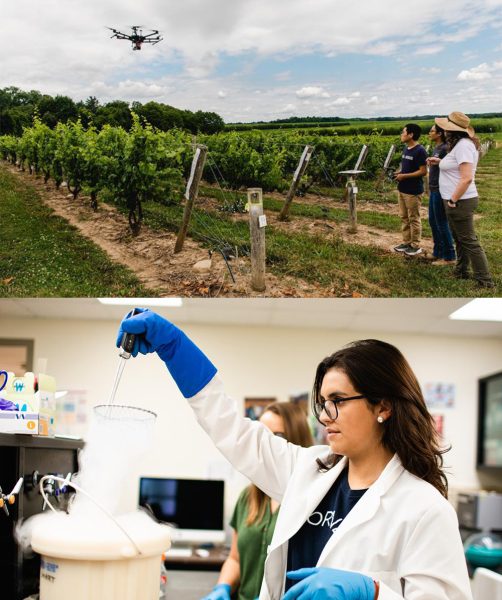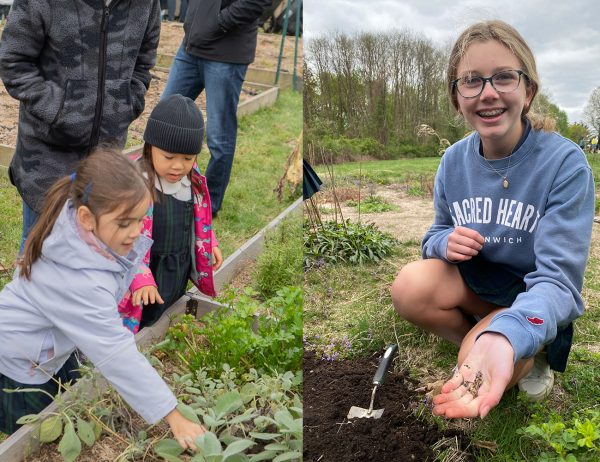The bell rings: time for lunch. In the Sacred Heart Greenwich Upper School hallway, students walk from their classrooms to the cafeteria. As they fill their plates with salads and make sandwiches, do they wonder about the origins of those vegetables, grains, meats, and dairy products? Although students may not consider agriculture on a daily basis, the industry is critical to their survival. Every day, farms feed a growing global population of over eight billion people, according to un.org. Despite the field’s keystone role in human society and breadth of applications in business, scientific, and technological careers, not enough recent graduates pursue professional occupations in farming. It is essential that more students cultivate an interest in agriculture to design solutions to food and conservation challenges of the future.
Each year, only about 35,400 university students earn degrees in agriculture-related studies. This number falls short of the industry’s growing demand, as there are 57,900 annual job openings for highly skilled agriculturalists. Consequently, about 40 percent of these jobs remain unfilled, according to usda.gov.

This is a concerning trend, given that agriculture is the source of basic human necessities such as food and clothing. As industry leaders retire, an insufficient number of university graduates are interested in taking on their positions. The most recent Census of Agriculture in 2017 reported that individuals aged 35 and younger accounted for just 9 percent of producers. It also revealed that the average age of American producers had once again increased from 56.3 to 57.5 years, according to usda.gov.
As ever, the field is filled with a myriad of compelling challenges that will have significant impacts on future human societies–nutritionally, environmentally, and economically. For example, how can farm managers balance affordability and efficiency with sustainability? The industry’s chemical fertilizers, cattle feedlots, and excessive freshwater consumption harm both regional ecosystems and global climate health. As governments tighten environmental restrictions, how will agriculturalists adapt while still making profits and feeding billions of people? This is just one question that modern producers face. With a decreasing and retiring population of industry professionals, it is imperative that students rise to these challenges and drive the food system to innovate.
Student indifference to the field stems from a variety of factors. One reason is the lack of exposure in secondary schools. While 80 percent of high school science teachers in the United States (US) believe agricultural education is essential, only 22 percent actually discuss agricultural applications in the classroom, according to agdaily.com. It is important that schools integrate agriculture into their curriculum in order to inspire students to pursue careers with related applications.
These curricula must address the modern-day opportunities in the food system instead of prolonging a stereotypical view of the occupation. While there are certainly farmers who wear overalls and hold pitchforks, these clichés do not apply to all agriculturalists. Today, farmers manage not only the corn fields of the Midwest, but also the rooftop farms of Brooklyn, New York and the laboratories where they work as genetic researchers to preserve crop diversity and adapt to climate change, according to nationalgeographic.com.

Furthermore, students must learn that a career as an agriculturalist has cross-disciplinary applications, from policy to economics to science, technology, mathematics, and engineering (STEM). In fact, of the 57,900 annual job openings in the field, about half are in management and business, while another quarter are in STEM, according to usda.gov. Schools can and should encourage students to consider these professions by integrating agricultural perspectives into existing science, mathematics, and humanities courses.
The integration of these programs must not only occur in rural school districts but also in urban and suburban areas. Historically, school-based agricultural education (SBAE) has been concentrated in rural and majority-white communities, according to eric.ed.gov. The result of this sectionalized exposure is a lack of cultural, regional, and ethnic diversity in professional farm sectors. As in other industries, a variety of perspectives enriches and spurs innovation, and innovation is critical to addressing the challenges of modern farming.
Truly, the progress of this industry will have significant impacts on the future of food, conservation, economics, politics, and demographics. The tide of agricultural technology has shaped the past 12,000 years of human history, from the domestication of ancient staple crops, which led to the first permanent settlements, to the 20th-century Green Revolution, which spread crop science to developing countries to mitigate starvation and slash poverty rates, according to nationalgeographic.com. Now, the means of sustaining the population and preserving natural resources rests in the hands of current students. It is up to school systems to facilitate agricultural exposure in the classroom, planting a seed of passion to inspire the innovators of the future.
Featured Image by Avery Kim ’24
This story was originally published on King Street Chronicle on November 7, 2023.




































